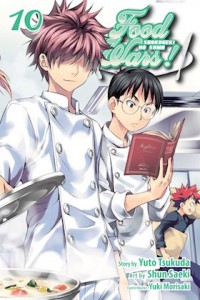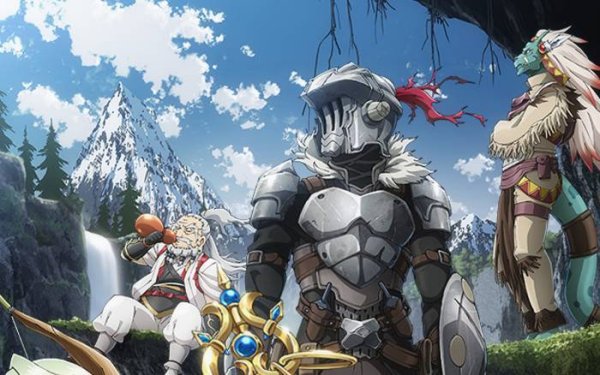
The Fall Classic continues with the two remaining quarterfinal battles resolved. Will Hayama’s pita kebab burger overcome Hisako’s turtle burger? Can Takumi Aldini see off the mysterious Subaru Mimisaka so that he can have his showdown with Soma?
Creative Staff:
Story: Yuto Tsukuda
Art: Shun Saeki
Contributor: Yuki Morisaki
Translation: Adrienne Beck
Production: Steven Dutro (Touch up art and lettering), Izumi Evers (design), Jennifer LeBlanc (editor)
What They Say:
It’s the last quarterfinal match of the Fall Classic. Takumi Aldini, looking for another chance to challenge Soma, faces off against the smug-looking Subaru Mimasaka. What’s making him so confident? The truth—and the dish he prepares—sends the entire auditorium into an uproar! Let the shokugeki begin!
Content: (please note that content portions of a review may contain spoilers)
If there is one thing that has been noticeable more and more as the years pass, it’s how pathetically one-dimensional most villains tend to be in manga and light novels (and by extension anime, much of which derives from these two sources). The better authors manage to create antagonists with a little more depth or complexity to them, but it must be tiring to do so (and perhaps beyond the capabilities of many writers). Food Wars has not been a series to indulge in the one-dimensional a little too much, even if it is chock full of cliches and genre conventions. In this volume, however, the author has trotted out a fairly straightforward and instantly unlikable villain in Subaru Mimisaka.
His appearance, that of a muscle-bound street punk, could be taken by the unwary as the easy marker of his “evilness” (good and evil are all quite relative in this world of cooking battles). This was already deliberately subverted by the outwards shows of hospitality and civility that Mimisaka showed towards Soma in the previous volume. No, his repulsive nature does not lie in physical violence. So what, then, makes Mimisaka so contemptible (which he most certainly is)? The first real clue should have been Eizan’s interest in him. What marks Eizan and just about anyone connected to him is, in a word, “malice.” Those drawn to Eizan do not just wish to defeat their opponents, they want their opponents to suffer in their defeat. It’s that added layer of malice that often makes a one-dimensional villain or his lackeys insufferable. Of course, most authors want you to feel that discomfort so that the victory of the “good guys” that will come later will feel all the more sweet.
This maliciousness is then compounded in Mimisaka’s case with outright creepiness (he’s a stalker, literally, of all his opponents) and topped with what would commonly be thought of by many as something of a sin when battles, such as shokugeki, that are meant to pit mind against mind are involved: he’s a hack who can only imitate, not innovate. Yes, Mimisaka takes his opponents’ dishes and improves on them, but such a cook (can one really use the word “chef” to denote someone who lacks any creativity of his own?) is but a mere practitioner, someone who can never be a master or an artist. His ability to win cooking battles might be unparalleled, but as even Eizan states in his soliloquy about his lackey, no restaurant would ever want to hire him. An executive chef or chef de cuisine who is incapable of developing new menus items, only refining what others create, will soon tire his or her customers’ palettes and will shortly be out of business.
But in Totsuki Academy, where all you need do is beat your opponent with the flavor of your dish, he is a formidable foe. And so it is with his quarterfinal battle/shokugeki against Takumi Aldini. Takumi battles as best as he can, but Mimisaka has anticipated every possible change or move the other could make. In this respect, the outcome is far different from how Akira Hayama defeated Hisako Arato at the start of the volume. Hayama won because he could see what Hisako’s limitations were and out-thought her. Mimisaka, too, searched out Takumi’s limitations, but all he did was one-up him. There wasn’t really any creativity involved. Mimisaka is capable of making a dish that tastes better than his opponent’s version. He is probably incapable of making a dish that tastes better if his opponent makes something completely different.
Soma knows all this and points out Mimisaka’s emptiness to his face: “you don’t know the real joy of cooking.”
So it would seem obvious how the next stage of the elections will go, as Mimisaka is pitted against Soma. The ultimate creative artist against the supreme copycat. For those thinking it will be simple, not so fast. Tsukuda has a habit of throwing his protagonist right up to the very precipice of defeat (think Eggs Before Dawn), only to have him drawn back to safety at the last moment. Soma has bet his life as a chef against Mimisaka’s creepy trophy collecting (in every shokugeki he’s won, he claims his opponent’s favored utensil as his prize). It’s probably going to be a nailbiter. And it’s that tension, which is apparent throughout much of this volume, which is the continuing draw.
Oh, and Erina Nakiri likes shoujo manga. Who knew?
In Summary:
Akira Hayama outdoes Hisako Arato, thinking beyond the limits that constrain Hisako’s imagination. Subaru Mimisaka, however, tests Takumi Aldini by making the same exact dessert as the Italian. Whose semifreddo will earn the judges’ votes, especially when the contest becomes a shokugeki as well? Truths about cooking and competitiveness are revealed and Soma stares into the abyss as the next round begins.
Content Grade: A-
Art Grade: A-
Package Rating: B+
Text/Translation: A-
Age Rating: Teen+ (16+)
Released By:Viz Media
Release Date: February 2nd, 2016
MSRP: $9.99



